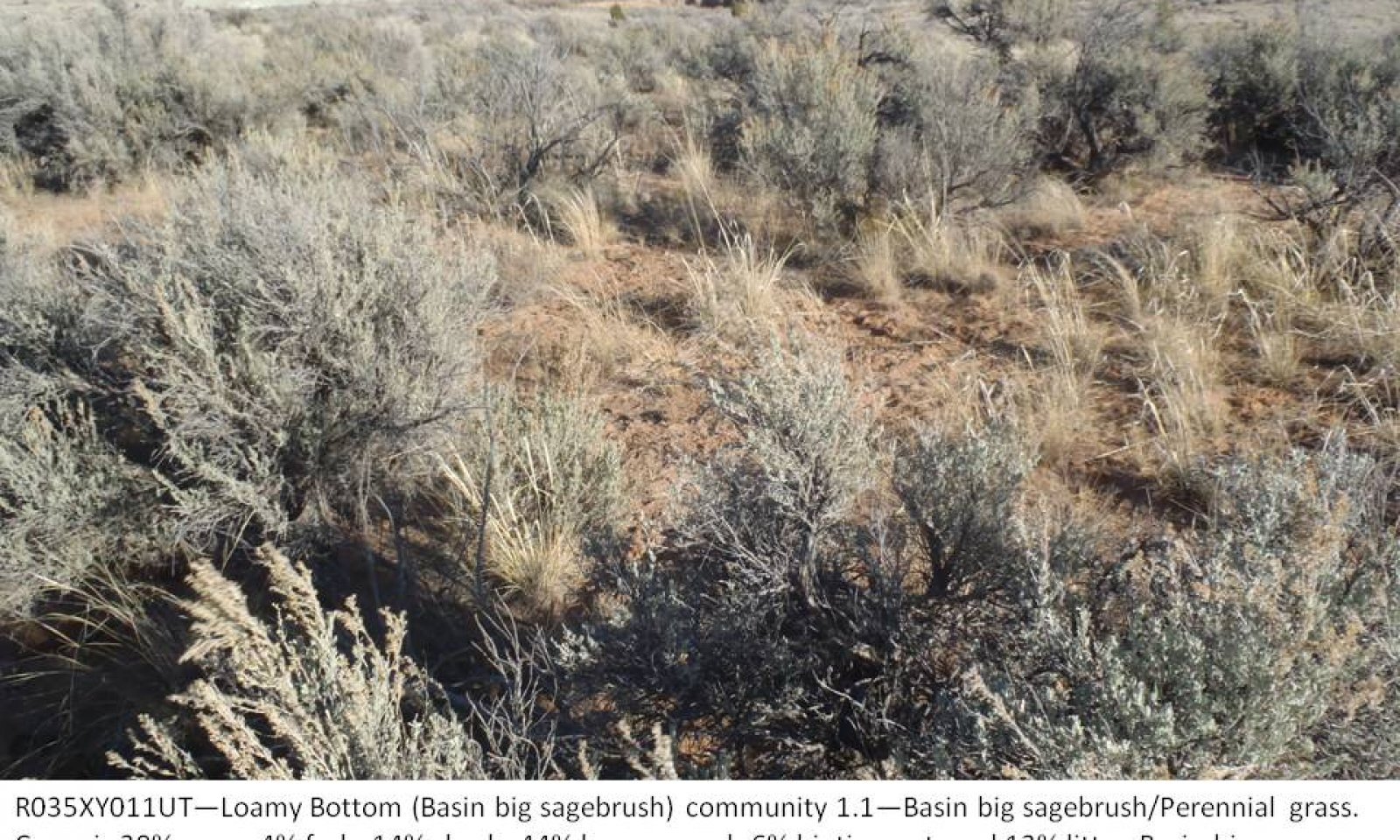

Natural Resources
Conservation Service
Ecological site R035XY011UT
Loamy Bottom (Basin Big Sagebrush)
Accessed: 04/24/2025
General information
Provisional. A provisional ecological site description has undergone quality control and quality assurance review. It contains a working state and transition model and enough information to identify the ecological site.
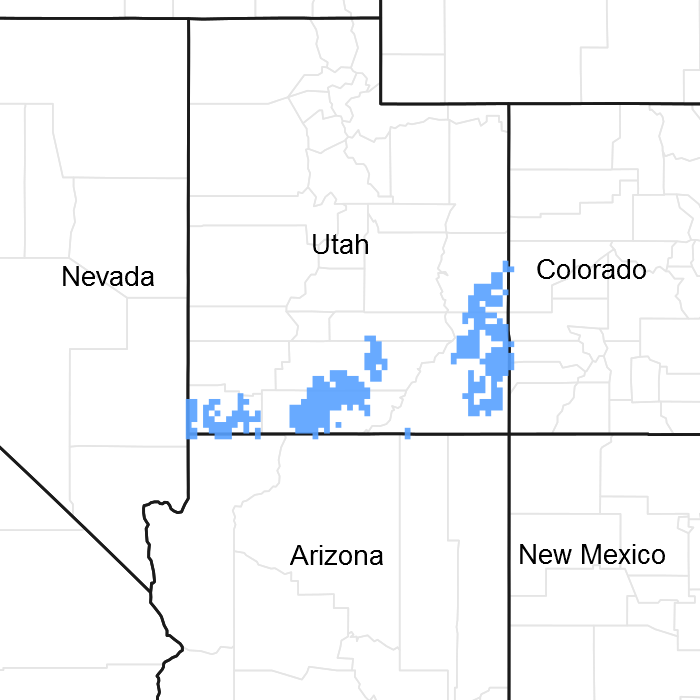
Figure 1. Mapped extent
Areas shown in blue indicate the maximum mapped extent of this ecological site. Other ecological sites likely occur within the highlighted areas. It is also possible for this ecological site to occur outside of highlighted areas if detailed soil survey has not been completed or recently updated.
MLRA notes
Major Land Resource Area (MLRA): 035X–Colorado Plateau
Site concept: The loamy bottom (basin big sagebrush) ecological site is a run-in site found on terraces near streams or washes. It is mostly in the semidesert climate zone (4,000-7,000 feet) of the Colorado and Green River Plateaus region (MLRA 35). The site occurs at the bottom of the watershed in areas that receive extra water and sediment from surrounding uplands. The soils are deep with very few rock fragments. Surface textures are usually sandy loams, but range from loams to loamy sands. These soils are most often classified as fluvents, with mesic soil moisture regimes and ustic aridic soil temperature regimes (can be aridic ustic in some areas). The reference plant community is dominated by basin big sagebrush, gooseberryleaf globemallow, Indian ricegrass, and needle-and-thread. Cheatgrass and Russian thistle are common invaders of the understory, and tamarisk is capable of dominating this site when it occurs on low stream terraces.
Associated sites
| R035XY003UT |
Alkali Bottom (Greasewood) The alkali bottom site is often found in the same landscape position as the loamy bottom site, but in areas with higher salinity and typically finer soil textures. In some areas, these two site intermingle as soils properties transition from saline to non-saline. |
|---|---|
| R035XY215UT |
Semidesert Sandy Loam (4-Wing Saltbush) This site is often found on stream terraces that are higher than those occupied by the loamy bottom site. On highly sloping floodplains and terraces, this site actually transitions into the loamy bottom site as it approaches the stream channel. |
Table 1. Dominant plant species
| Tree |
Not specified |
|---|---|
| Shrub |
(1) Artemisia tridentata ssp. tridentata |
| Herbaceous |
(1) Achnatherum hymenoides |
Physiographic features
This site is usually associated with a stream or a wash. It commonly occurs on flood plains, stream terraces, alluvial flats, and drainageways at elevations between 4,000 and 7,000 ft. Slopes are gentle and runoff potential is low. This site may have a seasonally high water table in the spring within 3 to 6 feet of the soil surface.
Table 2. Representative physiographic features
| Landforms |
(1)
Alluvial flat
(2) Flood plain (3) Stream terrace |
|---|---|
| Flooding duration | Extremely brief (0.1 to 4 hours) to brief (2 to 7 days) |
| Flooding frequency | None to rare |
| Ponding duration | Brief (2 to 7 days) |
| Ponding frequency | None to rare |
| Elevation | 1,219 – 2,134 m |
| Slope | 0 – 8% |
| Aspect | Aspect is not a significant factor |
Climatic features
Total annual precipitation for this site is typically 9 to 13 inches. The plant growing season is from mid March to mid October, and approximately 75% of the precipitaion occurs during the growing season. This site receives additional moisture during the growing season in the form of runoff or subsurface flow. January, February and June are typically the driest months; and April, August and October are the wettest months.
Table 3. Representative climatic features
| Frost-free period (average) | 162 days |
|---|---|
| Freeze-free period (average) | 187 days |
| Precipitation total (average) | 330 mm |
Figure 2. Monthly precipitation range
Figure 3. Monthly average minimum and maximum temperature
Influencing water features
This site may be associated with riparian ecological sites, but does not support riparian-obligate vegetation.
Soil features
The soils for this site are deep and well drained with very few rock fragments on the soil surface. The surface horizon (A horizon) is usually less than 4 inches thick. Surface textures are usually fine sandy loams, but can range from loams to fine sands. These soils formed from alluvium derived primarily from sandstone, shale, limestone and/or igneous parent materials. Subsoils are often stratified and are non-skeletal. Water holding capacity ranges from 2.5 to 6 inches of water in the upper 40 inches of soil. The soil temperature regime is mesic and the soil moisture regime is aridic or ustic aridic. Most often these soils are classified as fluvents.
Soils Associated with Site R035AY011UT
Organized by Soil Survey Area and Soil Components (Map units in parentheses):
Canyonlands Area (UT633)-Barnum (3); Jocity (43); Ustic Torrifluvents (97);
San Juan County, Central-(UT638) Gilco (12, 13, 14); Redbank family (42, 43); Suwanee (66);
San Juan County, Navajo (UT643)-Redbank (RED);
Capitol Reef National Park (UT685) -Begay, Mido family, Radnik;
Escalante Grand Staircase (UT686)-Baldfield family (5090); Escavda (5141); Flatnose (5120, 5210); Radnick, moist (5112, 5140, 5141, 5142, 5143, 5172, 5174);
Arches National Park (UT687)-Mido (110);
Canyonlands National Park (UT688)-Mido (22);
Typical Soil Profile:
C1--0-4 inches; fine sandy loam; slightly alkaline
C2--4-60 inches; stratified sandy loam; slightly alkaline
Table 4. Representative soil features
| Parent material |
(1)
Alluvium
–
volcanic sandstone
|
|---|---|
| Surface texture |
(1) Fine sandy loam (2) Loam (3) Fine sand |
| Family particle size |
(1) Loamy |
| Drainage class | Well drained |
| Permeability class | Moderately slow to moderately rapid |
| Soil depth | 152 cm |
| Surface fragment cover <=3" | 0 – 3% |
| Surface fragment cover >3" | 0 – 2% |
| Available water capacity (0-101.6cm) |
6.35 – 15.24 cm |
| Calcium carbonate equivalent (0-101.6cm) |
0 – 25% |
| Electrical conductivity (0-101.6cm) |
0 – 4 mmhos/cm |
| Sodium adsorption ratio (0-101.6cm) |
0 – 5 |
| Soil reaction (1:1 water) (0-101.6cm) |
7.4 – 9 |
| Subsurface fragment volume <=3" (Depth not specified) |
0 – 15% |
| Subsurface fragment volume >3" (Depth not specified) |
0 – 5% |
Ecological dynamics
This site was historically dominated by basin big sagebrush and a diverse perennial understory, including Indian ricegrass, gooseberryleaf globemallow, and needle-and-thread. The historic fire return interval is presumed to be about 50-100 years (Fryer and Luensmann 2012). Native grasses would have dominated for several years following fire, with sprouting shrubs increasing in the community. Sagebrush will most commonly re-establish and in the community within 10 years after the fire and increase steadily for 10-20 years until it dominates the overstory. In addition to fire, drought or aroga moths may cause sagebrush to decrease in the community.
Today this site often burns less frequently due to fire suppression efforts and reduce fine fuel loads resulting from improper livestock grazing. In addition, improper livestock grazing can cause native grasses and forbs to lose vigor or disappear from the community completely. Cheatgrass and Russian thistle commonly establish on this site, and Tamarisk can become dominant on low stream terraces. When the ecological processes are altered due to improper grazing, prolonged drought, altered fire regime, invasive species dominance, or other disturbances, alternative states can occur that differ from the historic reference state in both plant community structure and ecological function. In areas where irrigation is possible, this site has been used for cropland.
As stream channels are cut down, stream terraces occupied by the loamy bottom (basin big sagebrush) may cross an abiotic threshold into a semidesert sandy loam (Fourwing saltbush) site. This occurs when the site no longer recieves sufficient run-in moisture (via subsurface flow and/or runoff) to support a basin big sagebrush plant community. Fourwing saltbush dominance, stream downcutting, and a loss of skunkbrush sumac and other water-loving species indicate that a transition to a drier ecological site is occuring.
State and transition model
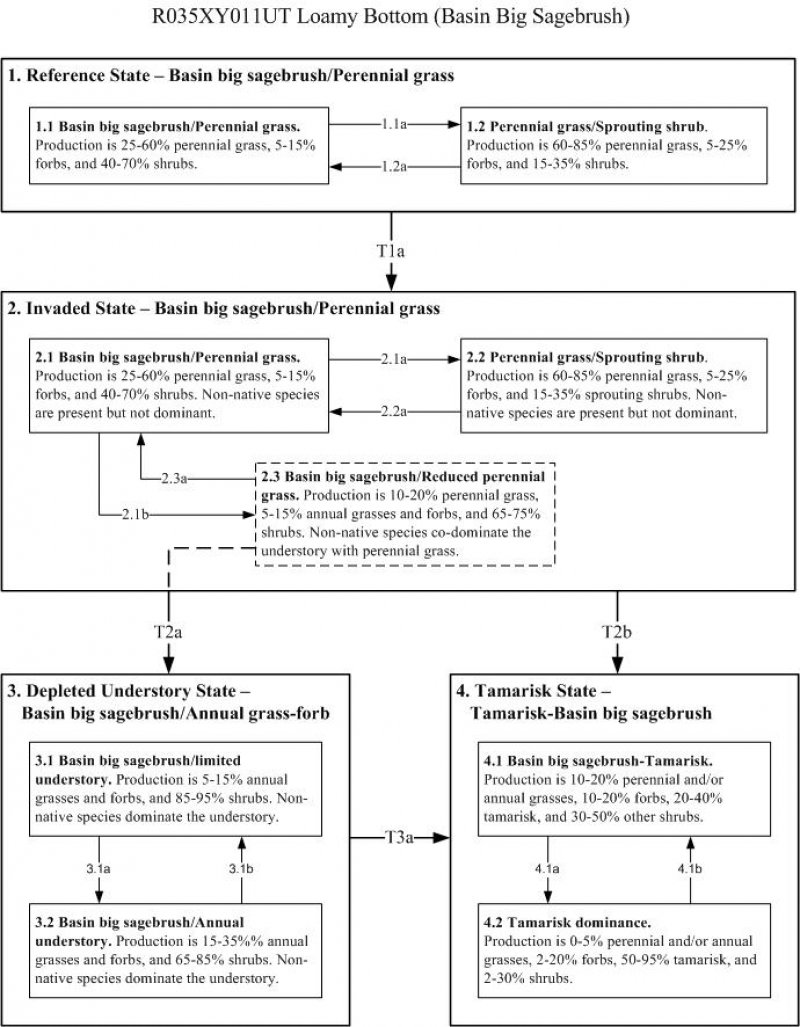
Figure 4. State-and-Transition Model
More interactive model formats are also available.
View Interactive Models
More interactive model formats are also available.
View Interactive Models
Click on state and transition labels to scroll to the respective text
State 1 submodel, plant communities
State 2 submodel, plant communities
State 3 submodel, plant communities
State 4 submodel, plant communities
State 1
Reference State
The reference state contains plant communities presumed to occur prior to the introduction of non-native plants, livestock grazing, and other modern disturbances. Basin big sagebrush dominance depends on time since fire, aroga moth, or extended drought.
Community 1.1
Basin big sagebrush/Perennial grass

Figure 5. phase 1.1
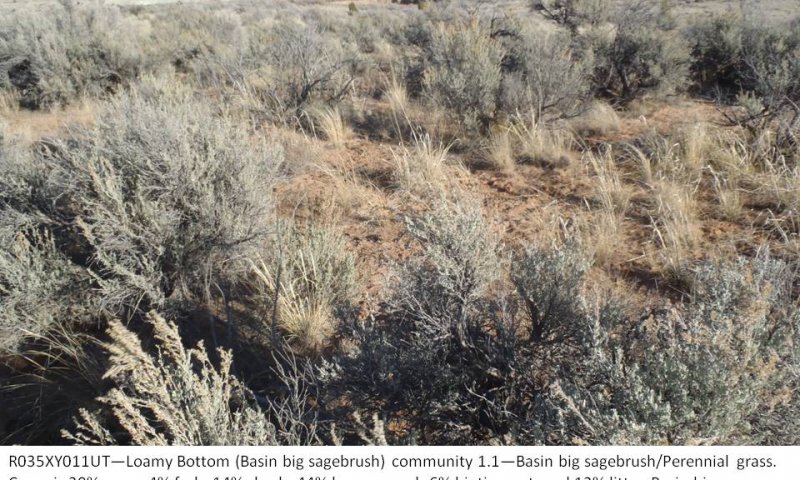
Figure 6.
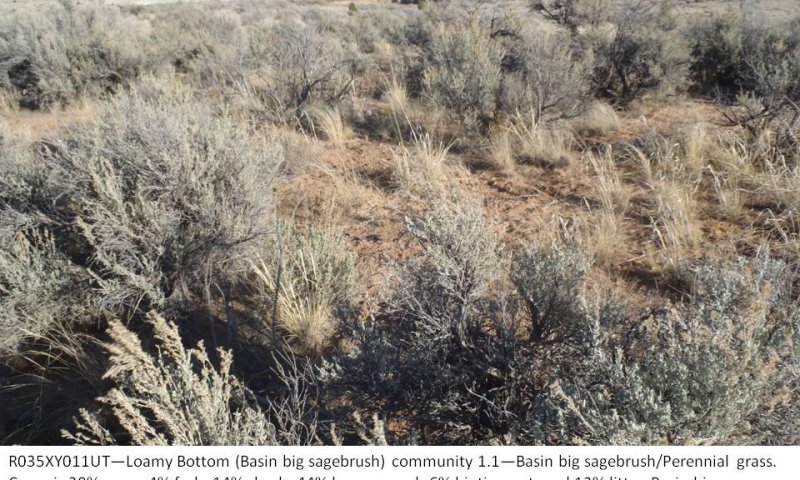
Figure 7.
Phase 1.1 is dominated by basin big sagebrush and perennial grasses. Percent composition by air-dry weight is 25-60% perennial grasses, 5-15% forbs, and 40-70% shrubs. In the reference state, this is the most common community phase.
Figure 8. Annual production by plant type (representative values) or group (midpoint values)
Table 5. Annual production by plant type
| Plant type | Low (kg/hectare) |
Representative value (kg/hectare) |
High (kg/hectare) |
|---|---|---|---|
| Shrub/Vine | 280 | 392 | 560 |
| Grass/Grasslike | 224 | 336 | 448 |
| Forb | 28 | 56 | 112 |
| Total | 532 | 784 | 1120 |
Table 6. Ground cover
| Tree foliar cover | 0% |
|---|---|
| Shrub/vine/liana foliar cover | 10-25% |
| Grass/grasslike foliar cover | 15-25% |
| Forb foliar cover | 3-6% |
| Non-vascular plants | 0% |
| Biological crusts | 0-10% |
| Litter | 10-20% |
| Surface fragments >0.25" and <=3" | 0-3% |
| Surface fragments >3" | 0% |
| Bedrock | 0% |
| Water | 0% |
| Bare ground | 30-45% |
Table 7. Canopy structure (% cover)
| Height Above Ground (m) | Tree | Shrub/Vine | Grass/ Grasslike |
Forb |
|---|---|---|---|---|
| <0.15 | – | – | – | – |
| >0.15 <= 0.3 | – | – | – | 0-5% |
| >0.3 <= 0.6 | – | 0-5% | 0-5% | 5-10% |
| >0.6 <= 1.4 | – | 10-20% | 10-20% | – |
| >1.4 <= 4 | – | 5-20% | – | – |
| >4 <= 12 | – | – | – | – |
| >12 <= 24 | – | – | – | – |
| >24 <= 37 | – | – | – | – |
| >37 | – | – | – | – |
Community 1.2
Perennial grass/Sprouting shrub
Phase 1.2 is dominated by perennial grasses. Percent composition by air-dry weight is 60-85% perennial grasses, 5-25% forbs, and 15-35% shrubs. Sprouting shrubs make up most of the shrub component. This phase is usually the result of stand-replacing fire that eliminates basin big sagebrush for the space of several years. Sagebrush may begin to re-establish in the community within 10 years following fire, and will steadily increase in the community until it becomes co-dominant with the perennial grass.
Pathway 1.1a
Community 1.1 to 1.2
Stand-replacing fire is the most common cause of this community pathway. The fire return interval is highly variable but usually occurs every 50-100 years (Fryer and Luensmann 2012). Sagebrush decreases and perennial grasses, forbs, and sprouting shrubs dominate the site. Aroga moth, low-intensity fires, and prolonged drought may also result in a substantial decrease in sagbrush, but do not necessarily eliminate it from the community.
Pathway 1.2a
Community 1.2 to 1.1
This pathway results from the establishment and natural increase of basin big sagebrush into the plant community 10-30 years following a fire.
State 2
Invaded State--Basin big sagebrush/Perennial grass
The invaded state is similar to the reference state in composition and ecological function, but allows for non-native species to be present. It also includes an at-risk plant community with reduced perennial grass production. When perennial grasses are losing vigor and the ability to propagate themselves, this state is at risk of transitioning to the depleted understory state, which is incapable of recoving perennial grasses without significant management inputs.
Community 2.1
Basin big sagebrush/Perennial grass
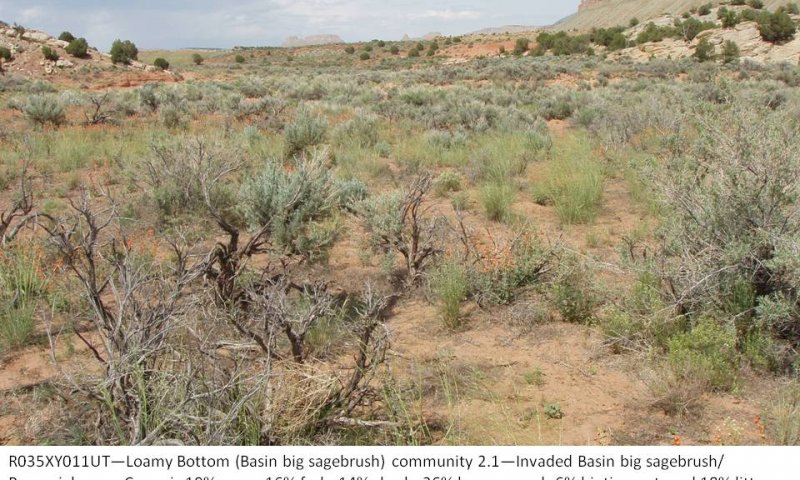
Figure 9. phase 2.1
Phase 2.1 is similar to the reference plant community in composition and ecological function, but it allows for the presence of non-native/invasive species. It is dominated by basin big sagebrush and perennial grasses. Percent composition by air-dry weight is 25-60% perennial grasses, 5-15% forbs, and 40-70% shrubs.
Figure 10. Annual production by plant type (representative values) or group (midpoint values)
Table 8. Annual production by plant type
| Plant type | Low (kg/hectare) |
Representative value (kg/hectare) |
High (kg/hectare) |
|---|---|---|---|
| Shrub/Vine | 280 | 392 | 560 |
| Grass/Grasslike | 224 | 336 | 448 |
| Forb | 28 | 56 | 112 |
| Total | 532 | 784 | 1120 |
Table 9. Ground cover
| Tree foliar cover | 0% |
|---|---|
| Shrub/vine/liana foliar cover | 10-25% |
| Grass/grasslike foliar cover | 15-25% |
| Forb foliar cover | 3-6% |
| Non-vascular plants | 0% |
| Biological crusts | 0-10% |
| Litter | 10-20% |
| Surface fragments >0.25" and <=3" | 0-3% |
| Surface fragments >3" | 0% |
| Bedrock | 0% |
| Water | 0% |
| Bare ground | 30-45% |
Table 10. Canopy structure (% cover)
| Height Above Ground (m) | Tree | Shrub/Vine | Grass/ Grasslike |
Forb |
|---|---|---|---|---|
| <0.15 | – | – | – | – |
| >0.15 <= 0.3 | – | – | – | 0-5% |
| >0.3 <= 0.6 | – | 0-5% | 0-5% | 5-10% |
| >0.6 <= 1.4 | – | 10-20% | 10-20% | – |
| >1.4 <= 4 | – | 5-20% | – | – |
| >4 <= 12 | – | – | – | – |
| >12 <= 24 | – | – | – | – |
| >24 <= 37 | – | – | – | – |
| >37 | – | – | – | – |
Community 2.2
Perennial grass/Sprouting shrub
Phase 2.2 is dominated by perennial grasses. It is similar to phase 1.2 in composition and ecological function, but allows for non-native/invasive species to be present. Percent composition by air-dry weight is 60-85% perennial grasses, 5-25% forbs, and 15-35% shrubs. Sprouting shrubs make up most of the shrub component. This phase is usually the result of stand-replacing fire that eliminates basin big sagebrush for the space of several years. Sagebrush may begin to re-establish in the community within 10 years following fire, and will steadily increase in the community until it becomes co-dominant with the perennial grass.
Community 2.3
Basin big sagebrush/Reduced perennial grass
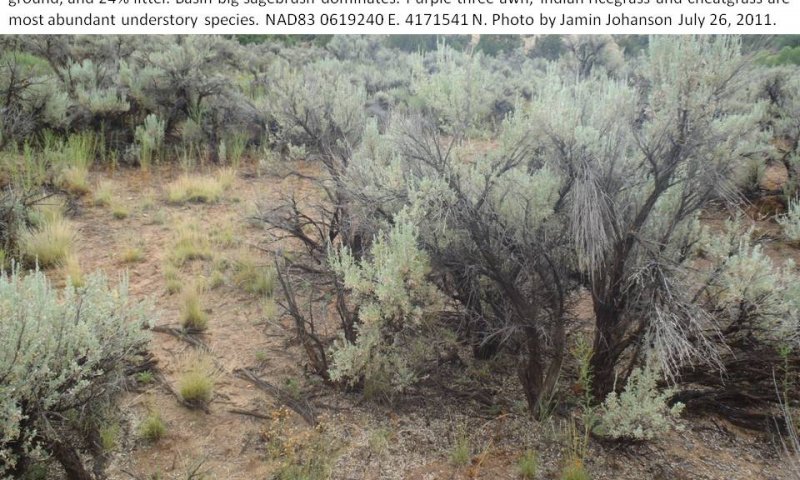
Figure 11. phase 2.3
Phase 2.3 is at-risk of crossing a threshold into the depleted understory state (state 3). Excessive grazing of perennial grasses during growth has favored non-native invasive species, primarily cheatgrass and/or Russian thistle, to co-dominate the understory. Prescribed grazing is required to improve the reproductive capability of perennial grasses and avoid the transition to state 3.
Figure 12. Annual production by plant type (representative values) or group (midpoint values)
Table 11. Annual production by plant type
| Plant type | Low (kg/hectare) |
Representative value (kg/hectare) |
High (kg/hectare) |
|---|---|---|---|
| Shrub/Vine | 280 | 392 | 560 |
| Grass/Grasslike | 84 | 168 | 252 |
| Forb | 28 | 56 | 112 |
| Total | 392 | 616 | 924 |
Pathway 2.1a
Community 2.1 to 2.2
Stand-replacing fire is the most common cause of this community pathway. The fire return interval is highly variable but usually occurs every 50-100 years (Fryer and Luensmann 2012). Sagebrush decreases and perennial grasses, forbs, and sprouting shrubs dominate the site. Aroga moth, low-intensity fires, and prolonged drought may also result in a substantial decrease in sagbrush, but do not necessarily eliminate it from the community.
Pathway 2.1b
Community 2.1 to 2.3


This pathway occurs when perennial grasses are reduced in the understory due to excessive grazing during the growing period. Perennial grasses are losing their ability to propagate themselves, and non-native species may co-dominate the understory.
Pathway 2.2a
Community 2.2 to 2.1
This pathway results from the establishment and natural increase of basin big sagebrush into the plant community 10-30 years following a fire.
Pathway 2.3a
Community 2.3 to 2.1


Prescribed grazing that provides rest during the growth period for perennial grasses can improve their vigor and reproductive capacity.
Conservation practices
| Prescribed Grazing |
|---|
State 3
Depleted Understory State--Basin big sagebrush/Annual grass-forb
The depleted understory state occurs when perennial grasses have been lost from the understory. Perennial forbs may also be reduced. This state is not as capable of carrying a stand replacing fire that removes big sagebrush due to a reduction in fine fules. As a result, sagebrush continues to increase and the understory continues to be reduced. Thinning of sagebrush by livestock trampling or other disturbance results in an increase in annual species in the understory.
Community 3.1
Basin big sagebrush/Limited understory
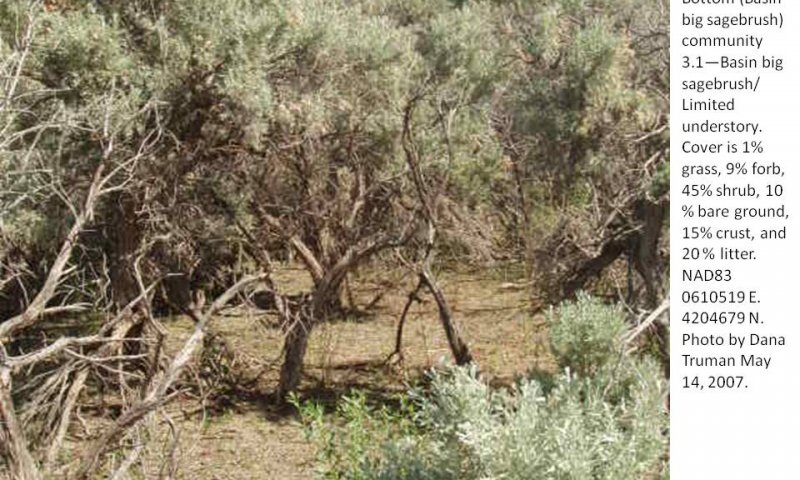
Figure 13. phase 3.1
Perennial grasses have been lost from the understory. Basin big sagebrush continues to increase beyond the natural fire return interval due to lack of fuel to carry a fire. Moss and biological soil crusts cover much of the soil surface.
Figure 14. Annual production by plant type (representative values) or group (midpoint values)
Table 12. Annual production by plant type
| Plant type | Low (kg/hectare) |
Representative value (kg/hectare) |
High (kg/hectare) |
|---|---|---|---|
| Shrub/Vine | 448 | 616 | 785 |
| Forb | 11 | 39 | 78 |
| Grass/Grasslike | – | 17 | 34 |
| Total | 459 | 672 | 897 |
Community 3.2
Basin big sagebrush/Annual understory
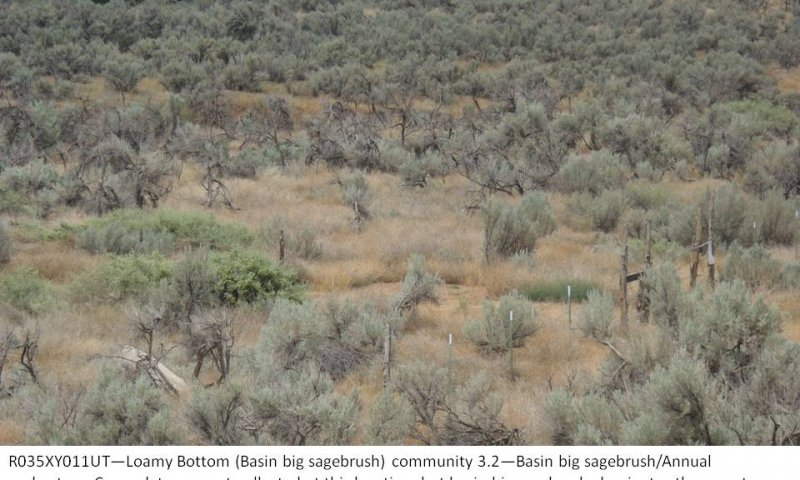
Figure 15. phase 3.2
This phase is dominated by basin big sagebrush in the overstory and annual grasses and/or forbs in the understory.
Figure 16. Annual production by plant type (representative values) or group (midpoint values)
Table 13. Annual production by plant type
| Plant type | Low (kg/hectare) |
Representative value (kg/hectare) |
High (kg/hectare) |
|---|---|---|---|
| Shrub/Vine | 336 | 448 | 616 |
| Forb | 28 | 56 | 196 |
| Grass/Grasslike | 56 | 112 | 168 |
| Total | 420 | 616 | 980 |
Pathway 3.1a
Community 3.1 to 3.2


Livestock trampling, mechanical treatment, or other disturbances reduces sagebrush cover and makes germination sites available for invasive annual species, particularly cheatgrass and Russian thistle.
Pathway 3.2a
Community 3.2 to 3.1


This pathway occurs when basin big sagebrush is not reduced by trampling, mechanical treatment, fire, or other disturbances for many years. Sagebrush increases and anuuals in the understory decrease.
State 4
Tamarisk State--Tamarisk-Basin big sagebrush
This state has only been documented on low stream terraces. The stream provides a corridor for tamarisk invasion, which spreads throughout the loamy bottom on low stream terraces, eventually dominating the site.
Community 4.1
Tamarisk-Basin big sagebrush
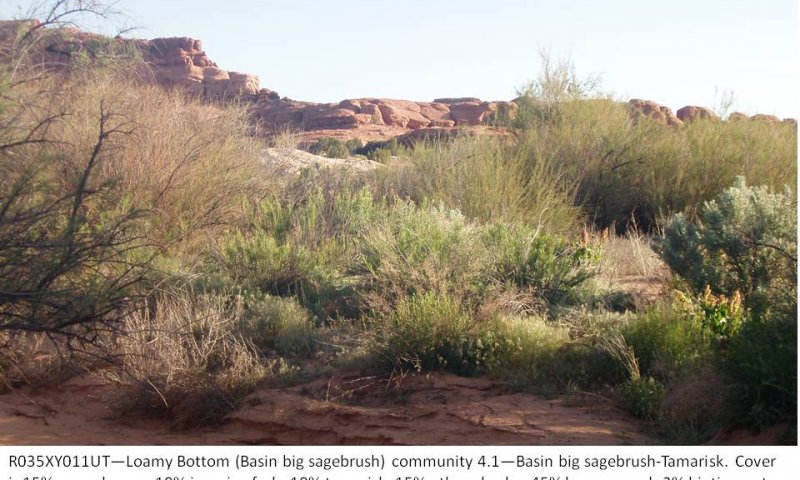
Figure 17. phase4.1
This community is co-dominated by basin big sagebrush and tamarisk. Production is 10-20% perennial and/or annual grasses, 10-20% forbs, 20-40% tamarisk, and 30-50% other shrubs.
Figure 18. Annual production by plant type (representative values) or group (midpoint values)
Table 14. Annual production by plant type
| Plant type | Low (kg/hectare) |
Representative value (kg/hectare) |
High (kg/hectare) |
|---|---|---|---|
| Shrub/Vine | 448 | 616 | 785 |
| Forb | 28 | 84 | 140 |
| Grass/Grasslike | 28 | 84 | 140 |
| Total | 504 | 784 | 1065 |
Community 4.2
Tamarisk dominance
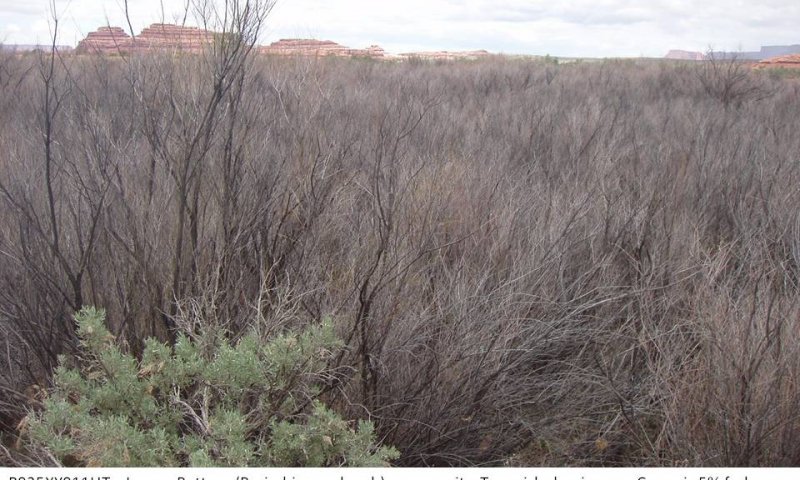
Figure 19. phase 4.2
This community occurs when tamarisk becomes the lone dominant species.
Figure 20. Annual production by plant type (representative values) or group (midpoint values)
Table 15. Annual production by plant type
| Plant type | Low (kg/hectare) |
Representative value (kg/hectare) |
High (kg/hectare) |
|---|---|---|---|
| Shrub/Vine | 448 | 673 | 1121 |
| Forb | 22 | 45 | 90 |
| Grass/Grasslike | – | 22 | 45 |
| Total | 470 | 740 | 1256 |
Pathway 4.1a
Community 4.1 to 4.2


This pathway occurs as tamarisk contiues to increase in the community by outcompeting basin big sagebrush as the dominant shrub.
Pathway 4.2a
Community 4.2 to 4.1


This community pathway may occur with tamarisk control efforts, either mechanical or biological. The saltcedar leaf beetle (Diorhabda elongata)can cause enough stress to kill tamarisk in 5-7 years (Richman, Biological Control Field Guide for Utah).
Transition T1a
State 1 to 2
Establishment and persistence of non-native species results in a transition from the reference state to the invaded state.
Transition T2a
State 2 to 3
This transition occurs when perennial grasses are reduced by improper grazing to the point that they can no longer self-propagate. Few remnant plants may still persist under shrubs, but re-establishment and dominance by perennial grasses will not occur following a fire, or with the removal of livestock grazing.
Transition T2b
State 2 to 4
This transition only occurs when the site is on low stream terraces. The stream provides a corridor for tamarisk invasion, which spreads to low terraces dominated by basin big sagebrush.
Transition T3a
State 3 to 4
This transition only occurs when the site is on low stream terraces. The stream provides a corridor for tamarisk invasion, which spreads to low terraces dominated by basin big sagebrush.
Additional community tables
Table 16. Community 1.1 plant community composition
| Group | Common name | Symbol | Scientific name | Annual production (kg/hectare) | Foliar cover (%) | |
|---|---|---|---|---|---|---|
|
Shrub/Vine
|
||||||
| 0 | Dominant Shrubs | 252–504 | ||||
| basin big sagebrush | ARTRT | Artemisia tridentata ssp. tridentata | 224–448 | – | ||
| rubber rabbitbrush | ERNA10 | Ericameria nauseosa | 17–56 | – | ||
| 3 | Sub-dominant shrubs | 28–112 | ||||
| skunkbush sumac | RHTRT | Rhus trilobata var. trilobata | 0–67 | – | ||
| greasewood | SAVE4 | Sarcobatus vermiculatus | 0–67 | – | ||
| Shrub (>.5m) | 2SHRUB | Shrub (>.5m) | 11–56 | – | ||
| fourwing saltbush | ATCA2 | Atriplex canescens | 0–34 | – | ||
| yellow rabbitbrush | CHVI8 | Chrysothamnus viscidiflorus | 0–34 | – | ||
| broom snakeweed | GUSA2 | Gutierrezia sarothrae | 0–28 | – | ||
| winterfat | KRLA2 | Krascheninnikovia lanata | 0–17 | – | ||
| plains pricklypear | OPPO | Opuntia polyacantha | 0–17 | – | ||
|
Grass/Grasslike
|
||||||
| 0 | Dominant Grasses | 112–336 | ||||
| needle and thread | HECO26 | Hesperostipa comata | 45–247 | – | ||
| Indian ricegrass | ACHY | Achnatherum hymenoides | 45–135 | – | ||
| 1 | Sub-dominant Grasses | 56–168 | ||||
| blue grama | BOGR2 | Bouteloua gracilis | 0–62 | – | ||
| Grass, perennial | 2GP | Grass, perennial | 17–56 | – | ||
| sand dropseed | SPCR | Sporobolus cryptandrus | 0–34 | – | ||
| mesa dropseed | SPFL2 | Sporobolus flexuosus | 0–34 | – | ||
| alkali sacaton | SPAI | Sporobolus airoides | 0–28 | – | ||
| squirreltail | ELEL5 | Elymus elymoides | 0–17 | – | ||
| James' galleta | PLJA | Pleuraphis jamesii | 0–17 | – | ||
| purple threeawn | ARPU9 | Aristida purpurea | 0–17 | – | ||
| Grass, annual | 2GA | Grass, annual | 0–11 | – | ||
| sixweeks fescue | VUOC | Vulpia octoflora | 0–6 | – | ||
|
Forb
|
||||||
| 2 | Forbs | 28–112 | ||||
| gooseberryleaf globemallow | SPGR2 | Sphaeralcea grossulariifolia | 6–56 | – | ||
| Forb, perennial | 2FP | Forb, perennial | 11–34 | – | ||
| silvery lupine | LUAR3 | Lupinus argenteus | 0–22 | – | ||
| cleftleaf wildheliotrope | PHCR | Phacelia crenulata | 0–22 | – | ||
| lemon scurfpea | PSLA3 | Psoralidium lanceolatum | 0–22 | – | ||
| tufted evening primrose | OECA10 | Oenothera caespitosa | 0–17 | – | ||
| Utah milkvetch | ASUT | Astragalus utahensis | 0–17 | – | ||
| Pacific aster | SYCHC | Symphyotrichum chilense var. chilense | 0–11 | – | ||
| Forb, annual | 2FA | Forb, annual | 2–11 | – | ||
| yellow spiderflower | CLLUL | Cleome lutea var. lutea | 0–6 | – | ||
| Wright's bird's beak | COWR2 | Cordylanthus wrightii | 0–6 | – | ||
| rosy ipomopsis | IPRO | Ipomopsis roseata | 0–6 | – | ||
| beardtongue | PENST | Penstemon | 0–6 | – | ||
Table 17. Community 2.1 plant community composition
| Group | Common name | Symbol | Scientific name | Annual production (kg/hectare) | Foliar cover (%) | |
|---|---|---|---|---|---|---|
|
Shrub/Vine
|
||||||
| 0 | Dominant Shrubs | 252–504 | ||||
| basin big sagebrush | ARTRT | Artemisia tridentata ssp. tridentata | 224–448 | – | ||
| rubber rabbitbrush | ERNA10 | Ericameria nauseosa | 17–56 | – | ||
| 3 | Sub-dominant shrubs | 28–112 | ||||
| skunkbush sumac | RHTRT | Rhus trilobata var. trilobata | 0–67 | – | ||
| greasewood | SAVE4 | Sarcobatus vermiculatus | 0–67 | – | ||
| Shrub (>.5m) | 2SHRUB | Shrub (>.5m) | 11–56 | – | ||
| fourwing saltbush | ATCA2 | Atriplex canescens | 0–34 | – | ||
| yellow rabbitbrush | CHVI8 | Chrysothamnus viscidiflorus | 0–34 | – | ||
| broom snakeweed | GUSA2 | Gutierrezia sarothrae | 0–28 | – | ||
| winterfat | KRLA2 | Krascheninnikovia lanata | 0–17 | – | ||
| plains pricklypear | OPPO | Opuntia polyacantha | 0–17 | – | ||
|
Grass/Grasslike
|
||||||
| 0 | Dominant Grasses | 112–336 | ||||
| needle and thread | HECO26 | Hesperostipa comata | 45–247 | – | ||
| Indian ricegrass | ACHY | Achnatherum hymenoides | 45–135 | – | ||
| 1 | Sub-dominant Grasses | 56–168 | ||||
| blue grama | BOGR2 | Bouteloua gracilis | 0–62 | – | ||
| Grass, perennial | 2GP | Grass, perennial | 17–56 | – | ||
| cheatgrass | BRTE | Bromus tectorum | 6–45 | – | ||
| sand dropseed | SPCR | Sporobolus cryptandrus | 0–34 | – | ||
| mesa dropseed | SPFL2 | Sporobolus flexuosus | 0–34 | – | ||
| alkali sacaton | SPAI | Sporobolus airoides | 0–28 | – | ||
| squirreltail | ELEL5 | Elymus elymoides | 0–17 | – | ||
| James' galleta | PLJA | Pleuraphis jamesii | 0–17 | – | ||
| purple threeawn | ARPU9 | Aristida purpurea | 0–17 | – | ||
| Grass, annual | 2GA | Grass, annual | 0–11 | – | ||
| sixweeks fescue | VUOC | Vulpia octoflora | 0–6 | – | ||
|
Forb
|
||||||
| 2 | Forbs | 28–112 | ||||
| prickly Russian thistle | SATR12 | Salsola tragus | 0–56 | – | ||
| gooseberryleaf globemallow | SPGR2 | Sphaeralcea grossulariifolia | 6–56 | – | ||
| redstem stork's bill | ERCI6 | Erodium cicutarium | 0–39 | – | ||
| stickseed | LAPPU | Lappula | 0–39 | – | ||
| Forb, perennial | 2FP | Forb, perennial | 11–34 | – | ||
| silvery lupine | LUAR3 | Lupinus argenteus | 0–22 | – | ||
| cleftleaf wildheliotrope | PHCR | Phacelia crenulata | 0–22 | – | ||
| lemon scurfpea | PSLA3 | Psoralidium lanceolatum | 0–22 | – | ||
| tufted evening primrose | OECA10 | Oenothera caespitosa | 0–17 | – | ||
| Utah milkvetch | ASUT | Astragalus utahensis | 0–17 | – | ||
| Pacific aster | SYCHC | Symphyotrichum chilense var. chilense | 0–11 | – | ||
| Forb, annual | 2FA | Forb, annual | 2–11 | – | ||
| rosy ipomopsis | IPRO | Ipomopsis roseata | 0–6 | – | ||
| yellow spiderflower | CLLUL | Cleome lutea var. lutea | 0–6 | – | ||
| Wright's bird's beak | COWR2 | Cordylanthus wrightii | 0–6 | – | ||
| beardtongue | PENST | Penstemon | 0–6 | – | ||
Table 18. Community 2.3 plant community composition
| Group | Common name | Symbol | Scientific name | Annual production (kg/hectare) | Foliar cover (%) | |
|---|---|---|---|---|---|---|
|
Shrub/Vine
|
||||||
| 0 | Dominant Shrubs | 224–448 | ||||
| basin big sagebrush | ARTRT | Artemisia tridentata ssp. tridentata | 224–448 | – | ||
| rubber rabbitbrush | ERNA10 | Ericameria nauseosa | 17–56 | – | ||
| 3 | Sub-dominant shrubs | 28–112 | ||||
| skunkbush sumac | RHTRT | Rhus trilobata var. trilobata | 0–67 | – | ||
| greasewood | SAVE4 | Sarcobatus vermiculatus | 0–67 | – | ||
| Shrub (>.5m) | 2SHRUB | Shrub (>.5m) | 11–56 | – | ||
| fourwing saltbush | ATCA2 | Atriplex canescens | 0–34 | – | ||
| yellow rabbitbrush | CHVI8 | Chrysothamnus viscidiflorus | 0–34 | – | ||
| broom snakeweed | GUSA2 | Gutierrezia sarothrae | 0–28 | – | ||
| plains pricklypear | OPPO | Opuntia polyacantha | 0–17 | – | ||
|
Grass/Grasslike
|
||||||
| 0 | Dominant Grasses | 84–224 | ||||
| Indian ricegrass | ACHY | Achnatherum hymenoides | 22–90 | – | ||
| needle and thread | HECO26 | Hesperostipa comata | 6–90 | – | ||
| cheatgrass | BRTE | Bromus tectorum | 6–67 | – | ||
| 1 | Sub-dominant Grasses | 28–84 | ||||
| blue grama | BOGR2 | Bouteloua gracilis | 0–50 | – | ||
| Grass, perennial | 2GP | Grass, perennial | 0–34 | – | ||
| purple threeawn | ARPU9 | Aristida purpurea | 0–17 | – | ||
| James' galleta | PLJA | Pleuraphis jamesii | 0–17 | – | ||
| alkali sacaton | SPAI | Sporobolus airoides | 0–17 | – | ||
| sand dropseed | SPCR | Sporobolus cryptandrus | 0–17 | – | ||
| mesa dropseed | SPFL2 | Sporobolus flexuosus | 0–17 | – | ||
| squirreltail | ELEL5 | Elymus elymoides | 0–11 | – | ||
| Grass, annual | 2GA | Grass, annual | 0–11 | – | ||
| sixweeks fescue | VUOC | Vulpia octoflora | 0–6 | – | ||
|
Forb
|
||||||
| 2 | Forbs | 28–112 | ||||
| prickly Russian thistle | SATR12 | Salsola tragus | 6–101 | – | ||
| redstem stork's bill | ERCI6 | Erodium cicutarium | 0–39 | – | ||
| gooseberryleaf globemallow | SPGR2 | Sphaeralcea grossulariifolia | 2–28 | – | ||
| lemon scurfpea | PSLA3 | Psoralidium lanceolatum | 0–17 | – | ||
| yellow bush lupine | LUAR | Lupinus arboreus | 0–17 | – | ||
| tufted evening primrose | OECA10 | Oenothera caespitosa | 0–11 | – | ||
| Forb, annual | 2FA | Forb, annual | 2–11 | – | ||
| Utah milkvetch | ASUT | Astragalus utahensis | 0–11 | – | ||
| cleftleaf wildheliotrope | PHCR | Phacelia crenulata | 0–11 | – | ||
| Pacific aster | SYCHC | Symphyotrichum chilense var. chilense | 0–11 | – | ||
| yellow spiderflower | CLLUL | Cleome lutea var. lutea | 0–6 | – | ||
| Wright's bird's beak | COWR2 | Cordylanthus wrightii | 0–6 | – | ||
| beardtongue | PENST | Penstemon | 0–6 | – | ||
| rosy ipomopsis | IPRO | Ipomopsis roseata | 0–6 | – | ||
Table 19. Community 3.1 plant community composition
| Group | Common name | Symbol | Scientific name | Annual production (kg/hectare) | Foliar cover (%) | |
|---|---|---|---|---|---|---|
|
Shrub/Vine
|
||||||
| 0 | Dominant Shrubs | 448–785 | ||||
| basin big sagebrush | ARTRT | Artemisia tridentata ssp. tridentata | 392–785 | – | ||
| rubber rabbitbrush | ERNA10 | Ericameria nauseosa | 28–112 | – | ||
| 3 | Sub-dominant shrubs | 56–168 | ||||
| fourwing saltbush | ATCA2 | Atriplex canescens | 0–112 | – | ||
| greasewood | SAVE4 | Sarcobatus vermiculatus | 0–112 | – | ||
| Shrub (>.5m) | 2SHRUB | Shrub (>.5m) | 11–67 | – | ||
| yellow rabbitbrush | CHVI8 | Chrysothamnus viscidiflorus | 0–34 | – | ||
| skunkbush sumac | RHTRT | Rhus trilobata var. trilobata | 0–17 | – | ||
| broom snakeweed | GUSA2 | Gutierrezia sarothrae | 0–6 | – | ||
| plains pricklypear | OPPO | Opuntia polyacantha | 0–6 | – | ||
|
Grass/Grasslike
|
||||||
| 1 | Grasses | 0–34 | ||||
| Grass, annual | 2GA | Grass, annual | 0–34 | – | ||
| Grass, perennial | 2GP | Grass, perennial | 0–17 | – | ||
|
Forb
|
||||||
| 2 | Forbs | 11–67 | ||||
| prickly Russian thistle | SATR12 | Salsola tragus | 0–67 | – | ||
| tumblemustard | THELY3 | Thelypodiopsis | 0–45 | – | ||
| Forb, annual | 2FA | Forb, annual | 0–34 | – | ||
| Forb, perennial | 2FP | Forb, perennial | 0–22 | – | ||
| madwort | ALYSS | Alyssum | 0–11 | – | ||
| goosefoot | CHENO | Chenopodium | 0–11 | – | ||
| tansymustard | DESCU | Descurainia | 0–11 | – | ||
| stickseed | LAPPU | Lappula | 0–11 | – | ||
| woolly plantain | PLPA2 | Plantago patagonica | 0–6 | – | ||
| redstem stork's bill | ERCI6 | Erodium cicutarium | 0–6 | – | ||
| yellow spiderflower | CLLU2 | Cleome lutea | 0–6 | – | ||
| Wright's bird's beak | COWR2 | Cordylanthus wrightii | 0–6 | – | ||
Table 20. Community 3.2 plant community composition
| Group | Common name | Symbol | Scientific name | Annual production (kg/hectare) | Foliar cover (%) | |
|---|---|---|---|---|---|---|
|
Shrub/Vine
|
||||||
| 0 | Dominant Shrubs | 280–504 | ||||
| basin big sagebrush | ARTRT | Artemisia tridentata ssp. tridentata | 252–448 | – | ||
| rubber rabbitbrush | ERNA10 | Ericameria nauseosa | 28–112 | – | ||
| 3 | Sub-dominant shrubs | 28–112 | ||||
| skunkbush sumac | RHTRT | Rhus trilobata var. trilobata | 0–67 | – | ||
| greasewood | SAVE4 | Sarcobatus vermiculatus | 0–67 | – | ||
| fourwing saltbush | ATCA2 | Atriplex canescens | 0–34 | – | ||
| yellow rabbitbrush | CHVI8 | Chrysothamnus viscidiflorus | 0–34 | – | ||
| broom snakeweed | GUSA2 | Gutierrezia sarothrae | 0–11 | – | ||
| plains pricklypear | OPPO | Opuntia polyacantha | 0–11 | – | ||
|
Grass/Grasslike
|
||||||
| 0 | Dominant Grasses | 28–140 | ||||
| cheatgrass | BRTE | Bromus tectorum | 28–140 | – | ||
| 1 | Sub-dominant grasses | 6–45 | ||||
| Grass, perennial | 2GP | Grass, perennial | 0–34 | – | ||
| Indian ricegrass | ACHY | Achnatherum hymenoides | 0–34 | – | ||
| purple threeawn | ARPU9 | Aristida purpurea | 0–28 | – | ||
| Grass, annual | 2GA | Grass, annual | 0–22 | – | ||
|
Forb
|
||||||
| 0 | Dominant Forbs | 28–140 | ||||
| prickly Russian thistle | SATR12 | Salsola tragus | 28–140 | – | ||
| tumblemustard | THELY3 | Thelypodiopsis | 0–140 | – | ||
| 2 | Sub-dominant forbs | 17–50 | ||||
| Forb, annual | 2FA | Forb, annual | 0–22 | – | ||
| Forb, perennial | 2FP | Forb, perennial | 0–22 | – | ||
| stickseed | LAPPU | Lappula | 0–17 | – | ||
| gooseberryleaf globemallow | SPGR2 | Sphaeralcea grossulariifolia | 0–17 | – | ||
| tufted evening primrose | OECA10 | Oenothera caespitosa | 0–11 | – | ||
| cleftleaf wildheliotrope | PHCR | Phacelia crenulata | 0–6 | – | ||
Table 21. Community 4.1 plant community composition
| Group | Common name | Symbol | Scientific name | Annual production (kg/hectare) | Foliar cover (%) | |
|---|---|---|---|---|---|---|
|
Shrub/Vine
|
||||||
| 0 | Dominant shrubs | 392–673 | ||||
| five-stamen tamarisk | TACH2 | Tamarix chinensis | 168–392 | – | ||
| basin big sagebrush | ARTRT | Artemisia tridentata ssp. tridentata | 112–224 | – | ||
| rubber rabbitbrush | ERNA10 | Ericameria nauseosa | 28–84 | – | ||
| 3 | Sub-dominant Shrubs | 28–84 | ||||
| fourwing saltbush | ATCA2 | Atriplex canescens | 0–45 | – | ||
| skunkbush sumac | RHTRT | Rhus trilobata var. trilobata | 0–45 | – | ||
| greasewood | SAVE4 | Sarcobatus vermiculatus | 0–45 | – | ||
| yellow rabbitbrush | CHVI8 | Chrysothamnus viscidiflorus | 0–22 | – | ||
| broom snakeweed | GUSA2 | Gutierrezia sarothrae | 0–11 | – | ||
| plains pricklypear | OPPO | Opuntia polyacantha | 0–6 | – | ||
|
Grass/Grasslike
|
||||||
| 0 | Dominant grasses | 28–140 | ||||
| needle and thread | HECO26 | Hesperostipa comata | 0–135 | – | ||
| Indian ricegrass | ACHY | Achnatherum hymenoides | 0–135 | – | ||
| cheatgrass | BRTE | Bromus tectorum | 6–112 | – | ||
| 2 | Sub-dominant grasses | 6–56 | ||||
| Grass, perennial | 2GP | Grass, perennial | 6–56 | – | ||
| Grass, annual | 2GA | Grass, annual | 0–11 | – | ||
|
Forb
|
||||||
| 1 | Forbs | 28–140 | ||||
| prickly Russian thistle | SATR12 | Salsola tragus | 0–112 | – | ||
| canaigre dock | RUHY | Rumex hymenosepalus | 0–45 | – | ||
| Forb, annual | 2FA | Forb, annual | 0–34 | – | ||
| Forb, perennial | 2FP | Forb, perennial | 0–34 | – | ||
| lambsquarters | CHAL7 | Chenopodium album | 0–11 | – | ||
| stickseed | LAPPU | Lappula | 0–11 | – | ||
Table 22. Community 4.2 plant community composition
| Group | Common name | Symbol | Scientific name | Annual production (kg/hectare) | Foliar cover (%) | |
|---|---|---|---|---|---|---|
|
Shrub/Vine
|
||||||
| 0 | Dominant Shrubs | 448–1121 | ||||
| five-stamen tamarisk | TACH2 | Tamarix chinensis | 448–1121 | – | ||
| 3 | Sub-dominant shrubs | 6–112 | ||||
| basin big sagebrush | ARTRT | Artemisia tridentata ssp. tridentata | 6–112 | – | ||
| fourwing saltbush | ATCA2 | Atriplex canescens | 0–22 | – | ||
| rubber rabbitbrush | ERNA10 | Ericameria nauseosa | 0–22 | – | ||
| greasewood | SAVE4 | Sarcobatus vermiculatus | 0–22 | – | ||
| yellow rabbitbrush | CHVI8 | Chrysothamnus viscidiflorus | 0–11 | – | ||
|
Grass/Grasslike
|
||||||
| 1 | Grasses | 0–45 | ||||
| cheatgrass | BRTE | Bromus tectorum | 0–28 | – | ||
| Grass, perennial | 2GP | Grass, perennial | 0–22 | – | ||
| Indian ricegrass | ACHY | Achnatherum hymenoides | 0–11 | – | ||
| sand dropseed | SPCR | Sporobolus cryptandrus | 0–11 | – | ||
| sixweeks fescue | VUOC | Vulpia octoflora | 0–11 | – | ||
| Grass, annual | 2GA | Grass, annual | 0–11 | – | ||
|
Forb
|
||||||
| 2 | Forbs | 28–84 | ||||
| white sagebrush | ARLU | Artemisia ludoviciana | 0–45 | – | ||
| Forb, annual | 2FA | Forb, annual | 0–34 | – | ||
| Forb, perennial | 2FP | Forb, perennial | 0–34 | – | ||
| tansymustard | DESCU | Descurainia | 0–34 | – | ||
| stickseed | LAPPU | Lappula | 0–11 | – | ||
| canaigre dock | RUHY | Rumex hymenosepalus | 0–11 | – | ||
| lambsquarters | CHAL7 | Chenopodium album | 0–11 | – | ||
| Wright's bird's beak | COWR2 | Cordylanthus wrightii | 0–6 | – | ||
Interpretations
Animal community
This site is suited to proper grazing by cattle and sheep during spring, summer, and fall, but requires sufficient rest during the growing season to maintain perennial grass. This site provides food and cover for diverse wildlife species.
Wood products
None
Supporting information
Other references
Fryer, Janet L. and Luensmann, P. S. 2012. Rapid Assessment Reference Condition Model for Basin Big Sagebrush in the Great Basin. In: Fire Effects Information System, [Online]. U.S. Department of Agriculture, Forest Service, Rocky Mountain Research Station, Fire Sciences Laboratory (Producer). Available: http://www.fs.fed.us/database/feis/fire_regime_table/fire_regime_table.html#GreatBasin [2012, April 17].
Richman, Amber. Biological Control Fieldguide for Utah. USDA-APHIS-PPQ.
Utah Climate Summaries. 2008. Available: http://www.wrcc.dri.edu/summary/climsmut.html. Accessed on February 25, 2008.
Grand Staircase: Radnik, moist – E of Boulder, along the Burr Trail, in the Circle Cliffs area; NE of Big Water in the Rogers Canyon Drainage on Fiftymile Mountain and drainages on Window Sash Bench; N of Big Water in drainages around Long Flat; W of Big Water along Highway 89 in the Kitchen Corral Wash drainage; SE of Escalante in the headwaters of the Alvey Wash and Wahweap Creek drainages; E of Kanab along Fivemile Valley, north of Hwy.
89 in the Paria River drainage, near the Paria Town Site; SE of Cannonville in Butler Valley; S of Cannonville near Sheep Creek; and in drainages NE of Tropic, along Henderson Creek and North Creek. (Modal – Latitude: 37° 33’ 45.52” N Longitude: 111° 19’ 9.83” W) Escavada – SE of Escalante in the headwaters of the Alvey Wash and Wahweap Creek drainages; W of Big Water along Highway 89 in the Kitchen Corral Wash drainage; NE of Big Water in drainages on Window Sash Bench; N of Big Water in drainages around Long Flat, and in drainages NE of Tropic, along Henderson Creek and North Creek. (Modal – Latitude: 37° 25’ 22.80” N Longitude: 111° 43’ 58.80” W) Flatnose – below the White Cliffs in the areas of Johnson Canyon and Nephi Pasture; along the Skutumpah Road from Skutumpah Terrace to Sheep
Creek Flat; and NE of Henrieville along Hwy. 12 along Henrieville Creek. (Modal – Latitude: 37° 9’ 9.01” N Longitude: 112° 16’ 3.30” W)
Capitol Reef: Begay Family – South Draw: 1,500 ft. W & 1,000 ft. N of the SE corner of Sec. 12, T. 30S. R. 7E. (Unsurveyed area, location description is estimated.)
East Coyote Wash, central part of San Juan County
Contributors
George Cook
Jamin Johanson
Susanne Mayne
Rangeland health reference sheet
Interpreting Indicators of Rangeland Health is a qualitative assessment protocol used to determine ecosystem condition based on benchmark characteristics described in the Reference Sheet. A suite of 17 (or more) indicators are typically considered in an assessment. The ecological site(s) representative of an assessment location must be known prior to applying the protocol and must be verified based on soils and climate. Current plant community cannot be used to identify the ecological site.
| Author(s)/participant(s) | Shane A. Green (NRCS), Robert D. Stager (BLM), Dana Truman (NRCS), Paul Curtis (BLM) and Randy Beckstrand (BLM). |
|---|---|
| Contact for lead author | shane.green@ut.usda.gov |
| Date | 09/10/2008 |
| Approved by | Shane A. Green |
| Approval date | |
| Composition (Indicators 10 and 12) based on | Annual Production |
Indicators
-
Number and extent of rills:
Very minor rill development in sparsely vegetated areas. Rills present should be widely spaced, and not connected. Rill development will increase following large storm events, but rills heal within a few years through frost heaving. Rill development may increase where the site is adjacent to other sites that produce large amounts of runoff (i.e. steeper sites, slickrock, etc.) -
Presence of water flow patterns:
Few throughout the site. Flow patterns are usually sinuous and wind around perennial plant bases. They may be long (10 to 20 feet), and less than one foot wide, and spaced form 5 to 15 feet apart. They are stable with only minor evidence of deposition. Evidence of flow will increase somewhat on slopes greater than 3 percent. This site is periodically inundated with runoff water due to its physiographic location. During very high flow events in adjacent channels (lotic, wash, etc.), this site may act as a filter and trap sediment, sometimes up to a foot or more. -
Number and height of erosional pedestals or terracettes:
Plants may show very minor pedestalling where they are adjacent to water flow patterns, but there should never be any exposed roots. Terracettes should be very few and stable, occurring behind pieces of woody litter blocking water flow patterns. -
Bare ground from Ecological Site Description or other studies (rock, litter, lichen, moss, plant canopy are not bare ground):
30-45%. Ground cover is based on the first raindrop impact, and bare ground is the opposite of ground cover. Ground cover + bare ground = 100%. -
Number of gullies and erosion associated with gullies:
Very few. They would usually be expected in the lowest part of the site where water flows concentrate and/or in locations where there are concentrated flows into the site from an adjacent area. Gullies may show minor signs of active erosion but the sides and bottoms would be mostly stabilized with perennial vegetation. Gullies may show more indication of erosion on slopes greater than 3 percent, or as influenced by adjacent areas (watersheds) that may be providing concentrated flow patterns. -
Extent of wind scoured, blowouts and/or depositional areas:
Very minor evidence of wind generated soil movement. Wind scoured (blowouts) and depositional areas are rarely if ever present. -
Amount of litter movement (describe size and distance expected to travel):
Due to the natural periodic concentration of runoff in this site, some fine litter movement is common. Often litter from adjacent sites/watershed contribute to litter noted on this ecological site. Litter removal may occur in flow patterns with deposition occurring at points of obstruction, especially following large storm events. Litter movement is expected to increase with slopes over 3 percent. -
Soil surface (top few mm) resistance to erosion (stability values are averages - most sites will show a range of values):
This site should have an erosion rating of 5 or 6 under plant canopies and a rating of 4 to 5 in the interspaces using the soil stability kit test. The average should be a 5. Surface texture is sandy loam to silt loam to clay loam. Vegetation cover, litter, and surface rock reduce erosion. -
Soil surface structure and SOM content (include type of structure and A-horizon color and thickness):
Soil surface horizon is 0-4 inches deep. Structure is weak granular. Colors are reddish brown. Use the specific information for the soil you are assessing found in the published soil survey to supplement this description. -
Effect of community phase composition (relative proportion of different functional groups) and spatial distribution on infiltration and runoff:
Vascular plants are expected to break raindrop impact and splash erosion. Spatial distribution of vascular plants slows runoff by obstructing surface flows to help create sinuous flow patterns that dissipate energy and allow time for infiltration. With the physiographic location of the site being in stream terraces, alluvial flats, drainage ways, and flood plains this site is one of the terminal accumulation sites for runoff water. As such, infiltration is naturally facilitated. Natural erosion would be expected in severe thunder storms or heavy spring runoff. When perennial grasses decrease, reducing ground cover and increasing bare ground, runoff is expected to increase and any associated infiltration reduced. -
Presence and thickness of compaction layer (usually none; describe soil profile features which may be mistaken for compaction on this site):
None. Due to this sites lower placement (bottoms, fans etc.), it accumulates fine particles such as sands, silts and clays. The associated soil structure is weak medium subangular blocky parting to weak fine to medium granular to weak thin to medium platy in the soil subsurface. These should not be considered to be compaction layers. -
Functional/Structural Groups (list in order of descending dominance by above-ground annual-production or live foliar cover using symbols: >>, >, = to indicate much greater than, greater than, and equal to):
Dominant:
Perennial bunchgrasses (Indian ricegrass, Needle and thread) > Non-sprouting shrubs (Basin big sagebrush, Fourwing saltbush)Sub-dominant:
sprouting shrubs (rabbitbrush, greasewood) > forbs (globemallow, asters, primrose)Other:
Functional/structural groups may appropriately contain non-native species if their ecological function is the same as the native species in the reference state (e.g. crested wheatgrass, etc.)
Biological soil crust is variable in its expression where present on this site and is measured as a component of ground cover.
Perennial and annual forbs can be expected to vary widely in their expression in the plant community based upon departures from average growing conditions.
Additional:
Assumed disturbance regime includes fire, insect, and floods that kill the non-sprouting shrubs.
Temporal variability is caused by fires, droughts, insects, etc. and spatial variability is caused by adjacency to other sites that produce runoff, soil pH levels, and topography.
Following a recent disturbance such as fire, drought, flood or insects that remove the woody vegetation, forbs and perennial grasses (herbaceous species) may dominate the community. If a disturbance has not occurred for an extended period of time, woody species may continue to increase crowding out the perennial herbaceous understory species. In either case, these conditions reflect a community phase within the reference state.
-
Amount of plant mortality and decadence (include which functional groups are expected to show mortality or decadence):
During years with average to above average precipitation, there should be very little recent mortality or decadence apparent in either the shrubs or grasses. Some mortality of bunchgrass and other shrubs may occur during very severe (long term) droughts. -
Average percent litter cover (%) and depth ( in):
Litter cover (including under plants) nearly all of which should be fine litter. Depth should be 1-2 leaf thickness in the interspaces and up to 1/2” under canopies. Litter cover may increase to 20-30% on some years due to increased plant production. -
Expected annual annual-production (this is TOTAL above-ground annual-production, not just forage annual-production):
600-1000 #/acre on an average year -
Potential invasive (including noxious) species (native and non-native). List species which BOTH characterize degraded states and have the potential to become a dominant or co-dominant species on the ecological site if their future establishment and growth is not actively controlled by management interventions. Species that become dominant for only one to several years (e.g., short-term response to drought or wildfire) are not invasive plants. Note that unlike other indicators, we are describing what is NOT expected in the reference state for the ecological site:
Tamarisk, cheatgrass, tumble mustard, and Russian thistle. -
Perennial plant reproductive capability:
All perennial plants should have the ability to reproduce sexually or asexually in most years, except in drought years.
Print Options
Sections
Font
Other
The Ecosystem Dynamics Interpretive Tool is an information system framework developed by the USDA-ARS Jornada Experimental Range, USDA Natural Resources Conservation Service, and New Mexico State University.
Click on box and path labels to scroll to the respective text.